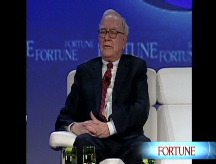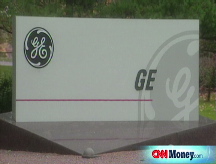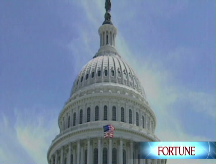GE under siege
For years GE Capital's profits powered its parent's earnings and helped finance its vast array of businesses. Now GE's biggest asset has turned into a liability that puts the future of the entire company at risk.
_graphic.gif)
 |
| Former CEO Jack Welch ranted on CNBC that he'd "shoot [Immelt] if he doesn't make what he promised now." |
 |
| Warren Buffett's $3 billion was about the most expensive capital it's possible to get. |
_graphic.gif)

(Fortune Magazine) -- When Warren Buffett went to bed at his Omaha home on the evening of Tuesday, Sept. 30, he asked his wife, Astrid, to wake him in the morning at 6:55 a.m. He had an important call coming in. By 7:30 the call was over. Buffett walked into the kitchen, still wearing an old robe he likes, and announced to a breakfast visitor that he had agreed to send General Electric $3 billion of Berkshire Hathaway money in return for a new issue of preferred stock and warrants allowing Berkshire to buy an equal amount of common stock over the next five years.
It was the beginning of one of the more dramatic days in GE's 130-year history.
The deal was done, but the news wasn't yet out, and in the meantime GE's world was deteriorating fast. By 9:14 Eastern time, a GE spokesman had e-mailed the media with a message that Congress must act "urgently" on the pending financial bailout package. By 11 an analyst at Deutsche Bank had announced that he was sharply cutting his forecast for GE's 2008 profits - though only three months remained in 2008 - and the stock dropped 9% almost immediately. By 11:23 the price of credit default swaps - lenders' insurance - on the bonds of GE Capital had rocketed: The market was saying that the bonds of this great and storied company, one of only six corporations on planet Earth with a triple-A credit rating, were junk.
Finally, at 1:44 p.m., GE (GE, Fortune 500) announced its deal with Buffett and said it would sell $12 billion of common stock to the public the following day. The statement contained an important sentence from Buffett: "I am confident that GE will continue to be successful in the years to come." GE stock edged up - though by day's end it was still way down since the start of the year.
So here's what had just happened: General Electric had arranged to raise $15 billion on a few days' notice. For perspective, remember that in March, Visa had culminated months of preparation by staging the largest stock offering ever, raising $18 billion. In other words, GE needed a sudden, huge, and utterly unexpected emergency infusion of cash. Only six days before, when a Wall Street analyst had asked GE chief Jeff Immelt about the possibility of the company's selling new equity, Immelt had answered unequivocally: "We just don't see it right now. We feel very secure about how the funding looks."
The idea that GE might ever be desperate for cash would have seemed ludicrous a year ago and looked unworthy of concern even this past summer. After all, this is history's most famously well-managed company. But now the stock trades for less than half its price 12 months ago. More than $200 billion of value has vaporized.
In its most recent earnings announcement, on Oct. 10, GE said profits fell 22% in the third quarter, driven down by a 38% drop in earnings from financial services; profits there should continue to decline, the company said. GE remains highly profitable; analysts expect it to earn about $20 billion this year, but that's 10% less than last year, a sharp change from earlier forecasts of robust growth. And for the first time in memory, investors are pricing GE at a level that indicates that they expect it to shrink rather than grow, a surreal situation.
Managing this crisis is certainly the sternest test Immelt has faced in his seven years as chief, and it may well become the episode that defines his legacy. Says Tom Priore, who runs the credit hedge fund ICP Structured Investments: "If you thought AIG was important, GE is many times a multiple of AIG." And now GE's future, like the economy's, looks as if it could tip either way.
To see how GE got so badly beaten up, consider first what the company really is. Its strength and curse is that it looks a lot like the economy. Over the decades GE's well-known manufacturing businesses - jet engines, locomotives, appliances, light bulbs - have shrunk as a proportion of the total. Like America, GE has long been mainly in the business of services. The most important and profitable services it offers are financial. In fact, though the average citizen probably thinks of GE as a great industrial company, its industry classification in the Fortune 500 is diversified financials. It is by far the largest company in that industry group. The next biggest - and here we begin to glimpse GE's troubles - are Fannie Mae (FNM, Fortune 500) and Freddie Mac (FRE, Fortune 500).
The reality is that for years, about half of GE's prodigious profits have come from General Electric Capital, a 100%-owned affiliate that files its own reports with the SEC. GE Capital, headed by 29-year GE veteran Michael Neal, has ventured into practically every kind of financial service, from making car loans in Europe to investing in commercial real estate in Florida. If you have a credit card from Wal-Mart or Lowe's, it's really from GE Capital. The business owns almost 1,800 commercial airplanes and leases them to 225 airlines. Until last year it made subprime mortgages in the U.S.
But GE Capital is more than just a major profit contributor to GE. The relationship is symbiotic. GE Capital helps GE by financing the customers that buy GE power turbines, jet engines, windmills, locomotives, and other products, offering low interest rates that competitors can't match. In the other direction, GE helps GE Capital by furnishing the reliable earnings and tangible assets that enable the whole company to maintain that triple-A credit rating, which is overwhelmingly important to GE's success. Company managers call it "sacred" and the "gold standard." Immelt says it's "incredibly important."
That rating lets GE Capital borrow funds in world markets at lower cost than any pure financial company. For example, Morgan Stanley's cost of capital is about 10.6% (as calculated by the EVA Advisers consulting firm). Citigroup's is about 8.4%. Even Buffett's Berkshire Hathaway (BRKA, Fortune 500) has a capital cost of about 8%. But GE's cost is only 7.3%, and in businesses where hundredths of a percentage point make a big difference, that's an enormously valuable advantage. And thanks to the earnings strength of GE's industrial side, GE Capital can maintain its rating without holding much capital on its balance sheet.
GE Capital also performs another critical function: It helps GE manage earnings. Though earnings management is a no-no among good-governance types, the company has never denied doing it, and GE Capital is the perfect mechanism. Since financial assets are, under normal conditions, far more liquid than tangible assets, the company can buy or sell them in the final days of a quarter so that reported earnings rise with comforting smoothness, right in line with Wall Street expectations. Investors happily pay extra for companies whose profits rise steadily rather than erratically, so this function is valuable. Michael Lewitt, president of the hedge fund Harch Capital Management, says GE Capital "has become such a necessary part of GE's legendary earnings results that General Electric could not perform as well or consistently if anything happened to it."
For GE Capital, the business world from 2002 to 2006 was a nearly perfect environment. Executives Gary Wendt and Denis Nayden had aggressively globalized the business, and now all the major economies (and most of the minor ones) were growing simultaneously at healthy clips, an unprecedented occurrence. Interest rates were low. Every kind of asset seemed to be appreciating. For a big finance operation with low funding costs, opportunity was everywhere. During that period GE Capital levered up, growing its ratio of debt to equity from 6.6 to 8.1. Profits quadrupled to almost $11 billion, more than the profits of Procter & Gamble or Goldman Sachs.
Good times never last forever, but GE is known for seeing changes ahead of time - recognizing early, for example, that it had to go "green" - and responding to them faster and more creatively than the competition. Last year, however, signs began turning up that this admirable pattern wasn't holding at GE Capital. For example, the company had left the home mortgage business in 2000 but reentered it in 2004 when it was flying high, buying a subprime lender called WMC Mortgage from a private equity firm (the price was never announced). Home prices peaked in June 2006, yet it wasn't until a year later, with the subprime crisis on the front page of every newspaper, that GE Capital finally decided to bail out. WMC lost almost $1 billion in 2007 before GE dumped it in December. A Japanese consumer-lending company called Lake was another lousy business, but GE Capital again didn't face the music until it was too late. GE took a $1.2 billion loss on it last year after deciding in September to sell it - but by then consumer credit was deteriorating so fast that unloading it (to Shinsei Bank) took another year.
This emerging pattern of confronting problems only after they could no longer be fixed was disturbing, but Immelt remained confident in GE Capital coming into this year. Despite its stumbles, GE has a long history of strict financial discipline. Immelt told shareholders in February, and repeated to employees recently, that GE had no exposure to collateralized debt obligations (CDOs) or structured investment vehicles (SIVs). It uses derivatives for hedging, which is relatively safe, but prohibits speculating in them, which is dangerous. It subjects its financial positions to shock tests - for example, assuming that interest rates rise a full percentage point across the board and stay there for a year; if that happened in 2008, Immelt said at the beginning of the year, GE's positions were so well hedged that the effect on profits would be negligible. His upbeat conclusion in February: "Our financial businesses should do well in a year like 2008."
That was more than just talk. In late 2007 and early 2008, Immelt spent about $10 million of his own money buying GE stock at prices in the middle to upper 30s.
Evidence that such optimism wasn't justified - and a hint of much bigger problems to come - finally arrived with a bang in April. That's when GE announced that first-quarter profits had fallen short of Wall Street's expectations by $700 million, a mammoth miss that by GE standards is historic. It's what prompted former CEO Jack Welch to rant on CNBC that he'd "get a gun out and shoot [Immelt] if he doesn't make what he promised now" for following quarters.
Making matters worse, Immelt had assured investors only 18 days before the quarter's end that everything was on track. GE's just-released annual report was titled "Invest and Deliver," significant because inside GE "deliver" is a special word. You deliver on commitments - always. As Welch said on CNBC, "Just deliver the earnings. Tell them you're going to grow 12% and deliver 12%."
So Immelt committed the ultimate GE sin and failed to deliver. How come? That's easy. He reassured investors on March 13, and the quarter ended on March 31. But something unimagined happened in between: Bear Stearns failed, causing credit markets nationwide to freeze up. GE had been counting on GE Capital to do its usual end-of-quarter rescue act, but this time it couldn't.
Result? Uproar and a further slide in the stock. Investors felt betrayed and disillusioned. Analyst Nicholas Heymann of Sterne Agee spoke for many when he wrote: "Investors now understand that GE uses the last couple weeks in the quarter to 'fine-tune' its financial service portfolios to ensure its earnings objectives are achieved. It turns out it really wasn't miracle management systems or risk-control systems or even innovative brilliance. It was the green curtain that allowed the magic to be consistently performed undetected."
-
 The retail giant tops the Fortune 500 for the second year in a row. Who else made the list? More
The retail giant tops the Fortune 500 for the second year in a row. Who else made the list? More -
 This group of companies is all about social networking to connect with their customers. More
This group of companies is all about social networking to connect with their customers. More -
 The fight over the cholesterol medication is keeping a generic version from hitting the market. More
The fight over the cholesterol medication is keeping a generic version from hitting the market. More -
 Bin Laden may be dead, but the terrorist group he led doesn't need his money. More
Bin Laden may be dead, but the terrorist group he led doesn't need his money. More -
 U.S. real estate might be a mess, but in other parts of the world, home prices are jumping. More
U.S. real estate might be a mess, but in other parts of the world, home prices are jumping. More -
 Libya's output is a fraction of global production, but it's crucial to the nation's economy. More
Libya's output is a fraction of global production, but it's crucial to the nation's economy. More -
 Once rates start to rise, things could get ugly fast for our neighbors to the north. More
Once rates start to rise, things could get ugly fast for our neighbors to the north. More













